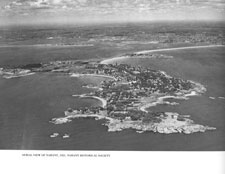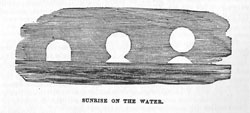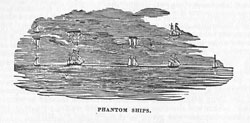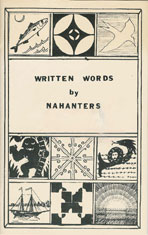Home > Nahant > Essays
For Such a Small Place: Poetry by the Sea
in Nahant
By Carl  Carlsen
Carlsen
Nahant. For such a small place, for just 3600 people, for
a place without a stoplight, there’s a lot of poetry.
What is it about Nahant that produces so much poetry, that
makes Nahant so poetic?
It’s geography that makes Nahant special. Nahant is
two islands connected to Lynn by two tombolos (a tombolo
is an isthmus that floods at high tide). In the old days,
the tombolos made Nahant a sort of magical place, or at least
one linked to the rhythms of nature since tide tables determined
when to cross to Nahant and when to return. Alonzo Lewis’ poem, “Nahant
Song” described the trip this way:
. . .O’er the shining sand
Far out in the tide, away from land;
And
we seem in the middle air to go,
With the sky above and the sky below!
Little Nahant is a forty acre triangle and Big Nahant
is a square mile  boomerang.
Theirs is a long shoreline of rocks and sand beaches that
has always fascinated poets, and for such a small place,
there are a lot of rocks and a lot of beaches. There’s
Long Beach and Short Beach before
you even get to Big Nahant, and from there, clockwise around
Big Nahant, it’s Stony Beach, Forty
Steps Beach, Canoe Beach, Joseph’s Beach, Curlew Beach,
Wharf Beach, Tudor Beach, Dorothy’s Beach, Pond Beach,
and finally Black Rock Beach. Then there are the
boomerang.
Theirs is a long shoreline of rocks and sand beaches that
has always fascinated poets, and for such a small place,
there are a lot of rocks and a lot of beaches. There’s
Long Beach and Short Beach before
you even get to Big Nahant, and from there, clockwise around
Big Nahant, it’s Stony Beach, Forty
Steps Beach, Canoe Beach, Joseph’s Beach, Curlew Beach,
Wharf Beach, Tudor Beach, Dorothy’s Beach, Pond Beach,
and finally Black Rock Beach. Then there are the  points
(protruding rocks), again going clockwise around
the boomerang from Short Beach: John’s Peril,
Mifflin’s
Point, East Point,
Bass Rocks, Bass Point, and Black Rock Point. Then
there are places with poetic names: Egg Rock, Pulpit Rock,
Castle Rock, Spouting Horn, Swallows’ Cave,
Pea Island. And then there is Little Nahant
with Wolf ’s Cove, Eastern Point, East Cliff, Fox Caverns,
Great Furnace, Mary’s Grotto, Simmons Spring, and Little
Furnace. For such small islands to have so many place names
(and these are not all of them!) suggests a strong connection
between Nahanters and their home.
points
(protruding rocks), again going clockwise around
the boomerang from Short Beach: John’s Peril,
Mifflin’s
Point, East Point,
Bass Rocks, Bass Point, and Black Rock Point. Then
there are places with poetic names: Egg Rock, Pulpit Rock,
Castle Rock, Spouting Horn, Swallows’ Cave,
Pea Island. And then there is Little Nahant
with Wolf ’s Cove, Eastern Point, East Cliff, Fox Caverns,
Great Furnace, Mary’s Grotto, Simmons Spring, and Little
Furnace. For such small islands to have so many place names
(and these are not all of them!) suggests a strong connection
between Nahanters and their home.
Another thing that’s special about Nahant is all the
doubling going on.  There
are the two Nahants, Little Nahant and Big Nahant, and the
two tombolos, one separating Little Nahant from Lynn, and
the other connecting Little Nahant to Big Nahant. The two
islands and the two tombolos create Long Beach and Short
Beach. And not only is
the doubling geographic, it’s visual too. Alonzo
Lewis, in his History of Lynn, provides illustrations
of a unique optical illusion seen near Nahant.
There
are the two Nahants, Little Nahant and Big Nahant, and the
two tombolos, one separating Little Nahant from Lynn, and
the other connecting Little Nahant to Big Nahant. The two
islands and the two tombolos create Long Beach and Short
Beach. And not only is
the doubling geographic, it’s visual too. Alonzo
Lewis, in his History of Lynn, provides illustrations
of a unique optical illusion seen near Nahant.  A
double image of the sun or a ship, one in the sky and one
in the water, occurs when certain cloud conditions prevail. In
Nahant’s poetry, the image of the double ship appears
in Nathan Ames’ epic “Pirates'
Glen and Dungeon Rock,” and then there is the double
sky in Lewis’ “Nahant
Song.”
A
double image of the sun or a ship, one in the sky and one
in the water, occurs when certain cloud conditions prevail. In
Nahant’s poetry, the image of the double ship appears
in Nathan Ames’ epic “Pirates'
Glen and Dungeon Rock,” and then there is the double
sky in Lewis’ “Nahant
Song.”
Doubling is what metaphor, the heart of poetry, is all about. Metaphor
is defined as speaking of one thing as if it were another. Doubling
could also refer, as metaphor does, to the literal (surface)
and figurative (hidden) meaning of things, and to the performance
of “feats of association,” as Robert Frost capsulized
the process of making metaphors.
 As
a symbol and an island, Nahant stands alone as a separate
land embodying beauty and serenity. The sea and the
sky, so prominent in Nahant’s landscape, represent
the fluidity and changeability of life, while the rocks of
Nahant: Egg Rock, Pulpit Rock, and Castle Rock, evoke stability
and permanence.
As
a symbol and an island, Nahant stands alone as a separate
land embodying beauty and serenity. The sea and the
sky, so prominent in Nahant’s landscape, represent
the fluidity and changeability of life, while the rocks of
Nahant: Egg Rock, Pulpit Rock, and Castle Rock, evoke stability
and permanence.
Nahant’s physical features make it an oasis of  nature
in a modern world. In the age of industrialization,
the reforestation of Nahant, as well as the creation of a “garden” by
Ice King Frederic Tudor, illustrate how Nahant was a breath
of nature among the smokestacks. In modern times, the
conflict between nature and “civilization” is
sometimes won by nature on Nahant, as evidenced by two poems
written in the context of World Wars I and II: Charles Hammond
Gibson’s “The
Forty Steps” and Sara Teasdale’s, “Nahant.”
nature
in a modern world. In the age of industrialization,
the reforestation of Nahant, as well as the creation of a “garden” by
Ice King Frederic Tudor, illustrate how Nahant was a breath
of nature among the smokestacks. In modern times, the
conflict between nature and “civilization” is
sometimes won by nature on Nahant, as evidenced by two poems
written in the context of World Wars I and II: Charles Hammond
Gibson’s “The
Forty Steps” and Sara Teasdale’s, “Nahant.”
With geography, physical features, place names, and doubling
as a foundation, the poetic traditions of Nahant have been
established by the poets whom the islands have inspired. Chief
among these is Henry Wadsworth Longfellow, who summered on
Nahant during most of the last half of the 1800’s,
a time that saw the blossoming of American literature and
the blossoming of the poetry of Nahant as well. Although
Longfellow’s stature alone may be enough to give Nahant
a place in the history and catalog of American poetry, other
famous American poets like John Greenleaf Whittier, Oliver
Wendell Holmes, and Sara Teasdale wrote poems about Nahant
as an island of serenity and beauty in a turbulent ocean.
 Throughout Nahant’s history, its poetic qualities
and traditions have also inspired its year round residents.
Nahant’s most famous homegrown poet, Annie Johnson,
known familiarly as “Annie of Nahant,” was a
prominent regional poet during the age of Longfellow and
of industrialization. More recently, Nahanters have
shown their support for the poetry of Nahant residents by
publishing two anthologies: Written Words by Nahanters (1976)
and Nahant Voices (1984). How Nahant inspires
the poetic vision of its residents is perhaps best shown
by Robert Risch’s poem, “Beach
Pebbles,” which
tells how a gift from his sons made him regard a beach pebble
as more than just a stone. Today, many practicing poets
are inspired by Nahant.
Throughout Nahant’s history, its poetic qualities
and traditions have also inspired its year round residents.
Nahant’s most famous homegrown poet, Annie Johnson,
known familiarly as “Annie of Nahant,” was a
prominent regional poet during the age of Longfellow and
of industrialization. More recently, Nahanters have
shown their support for the poetry of Nahant residents by
publishing two anthologies: Written Words by Nahanters (1976)
and Nahant Voices (1984). How Nahant inspires
the poetic vision of its residents is perhaps best shown
by Robert Risch’s poem, “Beach
Pebbles,” which
tells how a gift from his sons made him regard a beach pebble
as more than just a stone. Today, many practicing poets
are inspired by Nahant.
So Nahant in itself is poetic, in its geography and in its
natural beauty. Throughout its history, Nahant’s
scenery, serenity, and isolation have inspired its poets,
from the most ordinary to the most extraordinary.
Nahant and poetry belong in the same breath.